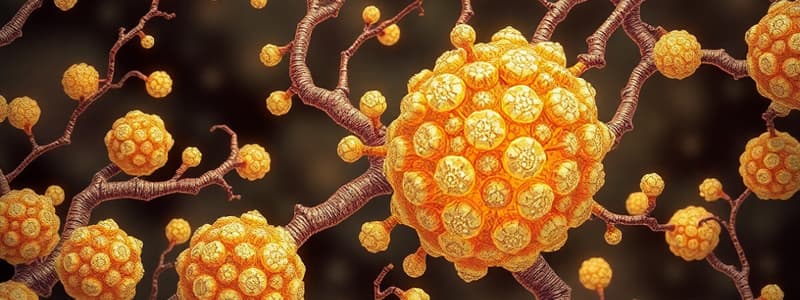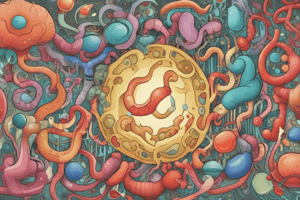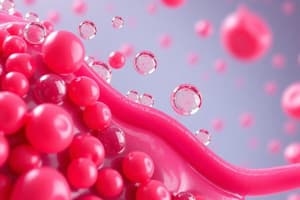Podcast
Questions and Answers
What structural feature of intestinal lacteals facilitates the entry of chylomicrons?
What structural feature of intestinal lacteals facilitates the entry of chylomicrons?
- Presence of goblet cells within the lacteal walls.
- Presence of tight junctions between endothelial cells.
- High concentration of digestive enzymes within the lacteal lumen.
- Lack of basement membranes and large gaps between endothelial cells. (correct)
What is the primary role of the protein coating on chylomicrons?
What is the primary role of the protein coating on chylomicrons?
- To make the complex water-soluble, allowing it to be suspended in interstitial fluid. (correct)
- To provide structural support to the lipid core of the chylomicron.
- To target the chylomicron to specific tissues for lipid delivery.
- To facilitate the breakdown of triglycerides into fatty acids and glycerol.
Why are chylomicrons secreted into the interstitial fluid by intestinal cells instead of directly into capillaries?
Why are chylomicrons secreted into the interstitial fluid by intestinal cells instead of directly into capillaries?
- Intestinal cells lack the necessary transport proteins to move chylomicrons into capillaries.
- The high blood pressure in capillaries would damage the chylomicrons.
- Capillaries are impermeable to lipoproteins.
- Chylomicrons are too large to diffuse into capillaries. (correct)
Through which vessel do chylomicrons eventually enter the systemic blood circulation?
Through which vessel do chylomicrons eventually enter the systemic blood circulation?
What enzyme is responsible for breaking down triglycerides from chylomicrons in the capillary walls?
What enzyme is responsible for breaking down triglycerides from chylomicrons in the capillary walls?
Following the breakdown of chylomicrons, what are the two primary fates of the released triglycerides?
Following the breakdown of chylomicrons, what are the two primary fates of the released triglycerides?
In the liver, chylomicron remnants contribute to the formation of which type of lipoprotein?
In the liver, chylomicron remnants contribute to the formation of which type of lipoprotein?
Which of the following is NOT a possible fate of cholesterol released from LDL in tissues?
Which of the following is NOT a possible fate of cholesterol released from LDL in tissues?
What is the primary function of HDL (high-density lipoprotein)?
What is the primary function of HDL (high-density lipoprotein)?
Why is the ratio of LDL to HDL considered an important indicator of cardiovascular health?
Why is the ratio of LDL to HDL considered an important indicator of cardiovascular health?
If an individual has a high LDL level and a low HDL level, which of the following health risks is most likely elevated?
If an individual has a high LDL level and a low HDL level, which of the following health risks is most likely elevated?
How would blocking the function of lipoprotein lipase affect triglyceride metabolism?
How would blocking the function of lipoprotein lipase affect triglyceride metabolism?
Which of the following processes would be directly impaired by a deficiency in apolipoproteins on chylomicrons?
Which of the following processes would be directly impaired by a deficiency in apolipoproteins on chylomicrons?
If a patient has a genetic defect that impairs the formation of lacteals, what would be the most likely consequence on lipid metabolism?
If a patient has a genetic defect that impairs the formation of lacteals, what would be the most likely consequence on lipid metabolism?
How does the consumption of a diet very high in saturated fats primarily affect the levels of LDL and HDL in the blood?
How does the consumption of a diet very high in saturated fats primarily affect the levels of LDL and HDL in the blood?
What is the immediate source of the monoglycerides and fatty acids from which intestinal cells synthesize new triglycerides?
What is the immediate source of the monoglycerides and fatty acids from which intestinal cells synthesize new triglycerides?
If the liver is damaged and unable to efficiently produce bile, how would this primarily affect lipid digestion and absorption?
If the liver is damaged and unable to efficiently produce bile, how would this primarily affect lipid digestion and absorption?
How does the body regulate cholesterol levels when there's an excess of cholesterol in cells?
How does the body regulate cholesterol levels when there's an excess of cholesterol in cells?
Which of the following is a potential consequence of having significantly reduced levels of HDL in the blood?
Which of the following is a potential consequence of having significantly reduced levels of HDL in the blood?
How do statin drugs, commonly prescribed to lower cholesterol, primarily work?
How do statin drugs, commonly prescribed to lower cholesterol, primarily work?
In what manner does vigorous exercise impact the levels of LDL and HDL cholesterol in the blood?
In what manner does vigorous exercise impact the levels of LDL and HDL cholesterol in the blood?
How does the consumption of omega-3 fatty acids typically affect lipid profiles?
How does the consumption of omega-3 fatty acids typically affect lipid profiles?
If a patient has a condition that reduces their lymphatic drainage, how would this MOST directly affect lipid transport?
If a patient has a condition that reduces their lymphatic drainage, how would this MOST directly affect lipid transport?
What is the MOST immediate effect of increased insulin secretion on triglyceride metabolism?
What is the MOST immediate effect of increased insulin secretion on triglyceride metabolism?
Which of the following BEST describes the role of bile salts in lipid digestion?
Which of the following BEST describes the role of bile salts in lipid digestion?
If a person has a genetic mutation causing a complete absence of LDL receptors, what would be the MOST likely consequence?
If a person has a genetic mutation causing a complete absence of LDL receptors, what would be the MOST likely consequence?
What is the PRIMARY mechanism by which plant sterols reduce blood cholesterol levels?
What is the PRIMARY mechanism by which plant sterols reduce blood cholesterol levels?
Which organ plays a CENTRAL role in both synthesizing new cholesterol and clearing cholesterol from the body?
Which organ plays a CENTRAL role in both synthesizing new cholesterol and clearing cholesterol from the body?
How would increased levels of glucagon in the body affect lipid metabolism?
How would increased levels of glucagon in the body affect lipid metabolism?
Which of the following is a direct function of cholesterol in the human body?
Which of the following is a direct function of cholesterol in the human body?
How can genetic factors influence an individual's cholesterol levels and risk of cardiovascular disease?
How can genetic factors influence an individual's cholesterol levels and risk of cardiovascular disease?
What effect does the hormone leptin, which is produced by adipose tissue, have on lipid metabolism?
What effect does the hormone leptin, which is produced by adipose tissue, have on lipid metabolism?
How does the process of esterification relate to triglyceride metabolism in intestinal cells?
How does the process of esterification relate to triglyceride metabolism in intestinal cells?
Which of the following is the MAIN reason that phospholipids are essential components of lipoproteins, such as chylomicrons, LDL, and HDL?
Which of the following is the MAIN reason that phospholipids are essential components of lipoproteins, such as chylomicrons, LDL, and HDL?
How does intermittent fasting potentially impact lipid metabolism and cardiovascular health?
How does intermittent fasting potentially impact lipid metabolism and cardiovascular health?
If someone's body cannot produce apolipoprotein B, which is necessary for the formation of VLDL and LDL, how would this specifically affect fat transport and cholesterol levels?
If someone's body cannot produce apolipoprotein B, which is necessary for the formation of VLDL and LDL, how would this specifically affect fat transport and cholesterol levels?
What role does the enzyme acyl-CoA:cholesterol acyltransferase (ACAT) play in cholesterol metabolism within cells?
What role does the enzyme acyl-CoA:cholesterol acyltransferase (ACAT) play in cholesterol metabolism within cells?
How does the consumption of trans fats primarily affect lipid metabolism and cardiovascular health?
How does the consumption of trans fats primarily affect lipid metabolism and cardiovascular health?
Flashcards
What are chylomicrons?
What are chylomicrons?
Lipid-protein complexes that contain insoluble lipids and are made water-soluble by a coating of phospholipids and proteins.
How do lipids enter intestinal cells?
How do lipids enter intestinal cells?
They diffuse across the plasma membrane and enter the cytosol.
Where do chylomicrons diffuse?
Where do chylomicrons diffuse?
Intestinal lacteals of the lymphatic system due to lacking basement membranes and large gaps between endothelial cells.
What happens to chylomicrons after entering the bloodstream?
What happens to chylomicrons after entering the bloodstream?
Signup and view all the flashcards
What happens to triglycerides that diffuse into tissues?
What happens to triglycerides that diffuse into tissues?
Signup and view all the flashcards
What is LDL?
What is LDL?
Signup and view all the flashcards
How is cholesterol used in the body?
How is cholesterol used in the body?
Signup and view all the flashcards
Why is the LDL to HDL ratio important?
Why is the LDL to HDL ratio important?
Signup and view all the flashcards
What is HDL?
What is HDL?
Signup and view all the flashcards
Study Notes
Micelle Contact and Lipid Diffusion
- Lipids diffuse across the plasma membrane and enter the cytosol when a micelle contacts the intestinal epithelium.
- Intestinal cells synthesize new triglycerides from monoglycerides, fatty acids, and glycerol.
- Triglycerides, cholesterol, phospholipids, and lipid-soluble materials are coated with proteins, forming chylomicrons.
- Chylomicrons are lipoproteins that contain insoluble lipids.
- The phospholipid and protein coating makes chylomicrons water soluble.
- Intestinal cells secrete chylomicrons into interstitial fluid via exocytosis.
- The protein coating keeps chylomicrons suspended in interstitial fluid.
- Chylomicrons are too large to diffuse into capillaries.
- Chylomicrons diffuse into the intestinal lacteals of the lymphatic system after being released.
- Intestinal lacteals lack basement membranes and have large gaps between endothelial cells so that the chylomicrons can move into the lymphatic ducts.
Chylomicron Movement and Breakdown
- Chylomicrons move from lacteals to the thoracic duct.
- They then drain into systemic blood through the left thoracic duct on the left subclavian vein.
- Chylomicrons are either broken down into triglycerides by lipoprotein lipase in capillary walls or transported into the liver.
- Triglycerides diffuse into tissues and are stored in adipose cells or used by muscle for energy.
Cholesterol and Lipoproteins
- Chylomicrons in the liver form LDL, which carries cholesterol to tissues.
- Released cholesterol can be used in three ways: to make steroid hormones and compounds like Vitamin D3; for energy; or it can form plaques and clog blood vessels.
- Excess cholesterol is carried back to the liver to be recycled or excreted in bile by binding to high density lipoproteins (HDL).
- The ratio of LDL to HDL is an important indicator of health.
- Having more HDL and less LDL is optimal for cholesterol management.
Studying That Suits You
Use AI to generate personalized quizzes and flashcards to suit your learning preferences.




